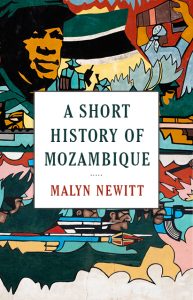A Short History of Mozambique
A Short History of Mozambique By Malyn Newitt (Oxford, UK: Oxford University Press, 2017,) pp. 254 A typical American asked to name European countries that created colonies in Africa would probably respond with either France or Britain and might not even realize that Italy, Germany, Spain, Belgium, and most importantly, Portugal, also formed colonies throughout the continent. Although various ancient civilizations had colonies in Africa, Portugal was the first to establish African colonies during early modern European history. When the “Scramble for Africa” ended, Europe recognized Portuguese control over five territories, including Mozambique. It is unlikely that many Americans could identify Mozambique on a map, much less know anything about the country’s history. Malyn Newitt’s book on Mozambique is an attempt to rectify this lack of knowledge, presenting a brief but somewhat detailed account of the country. Initially discussing the geography and ethnography of the country, Newitt explains how the nation’s rivers play a significant role in terms of their impact on trade and migration, as well as a somewhat negative effect by creating geographical divisions within the country. Furthermore, he discussed Mozambique’s climate with a focus on various droughts that have significantly impacted the country. Regarding Mozambique’s ethnography, he notes that despite the ethnic diversity that exists it is often a changing dynamic, as an ethnic identity at times was often tied to the more powerful groups that acquired control over parts of the country. Throughout Mozambican history, smaller tribal groups often identified themselves with other tribes that subjected them to their authority. This latter element played a significant role in the conduct of the civil war between 1977 and 1992. Chapters two through six focus on Europe’s role, especially Portugal’s impact on Mozambique, while the last three chapters examine Mozambique’s history post-independence. Newitt discusses how trade, initially centered on ivory and gold, and later slaves helped establish the importance of this land to Portugal. He notes geographical and environmental factors as well as resistance from the Africans and other groups placed limitations on the effectiveness of Portugal’s colonization efforts. Yet, Mozambique’s economic impact on increasing Portugal’s wealth was not directly related to the resources within the country, but rather an opportunity to “rent” the territory to interested Portuguese companies or individuals. Portuguese kings allowed various Portuguese citizens to acquire multiyear contracts to exploit Mozambique in exchange for paying Portugal for the privilege of accessing the natural resources and markets of Mozambique. Later, Portugal decided to restore direct governmental control over the country. Newitt’s final chapters focus on Mozambique’s independence movement, a multiyear civil war, and post-civil war government policies. Despite native Mozambican resistant by Frelimo, a significant movement within the country, and others Mozambicans against Portuguese force, independence was gained more by the “Carnation Revolution” in Portugal that called for ending military involvement in Portuguese colonies. Essentially handed governmental power by Portugal, Frelimo established a pro-Marxist system without holding elections. Northern Mozambicans organized Renamo, an anti-Marxist group that fought a civil war against Frelimo. Newitt reviews the various military, diplomatic, and political efforts surrounding the fifteen-year war, as well as discussing more recent history. Political discontent is still present, as Frelimo still controls most of Mozambique’s political institutions. Currently ranked near the bottom of many economic and development scales, Newitt states that the country has become overly dependent upon foreign aid for much of its current operating budget. Improving modern Mozambique’s significant political and economic difficulties requires the government to address multiple issues. Newitt argues that Mozambique will need to increase educational and employment opportunities to improve the country’s standing. Additionally, he notes that although possibilities exist to develop the natural resources, this will require foreign investment in large projects such as hydroelectric dams or mining projects and a stable political situation. Newitt’s book is an excellent work for anybody interested in learning about Mozambique’s history, providing a brief but detailed look at various eras of the country from the pre-European period up through modern-day Mozambique. Students and individuals interested in Portugal’s colonial policies, Mozambique, or Southern Africa can benefit from this book. Using a variety of primary and secondary sources, Newitt presents a well-researched and well-written book, along with two maps, several photographs, as well as a glossary of Portuguese terms used throughout the book. The addition of a few more maps would benefit this book, as in several sections the author mentions particular movements and events that, unless the reader has a significant understanding of the locations, can be a bit challenging to follow. Still, I would not hesitate to recommend this work to those wanting to learn about Mozambique’s history. |



